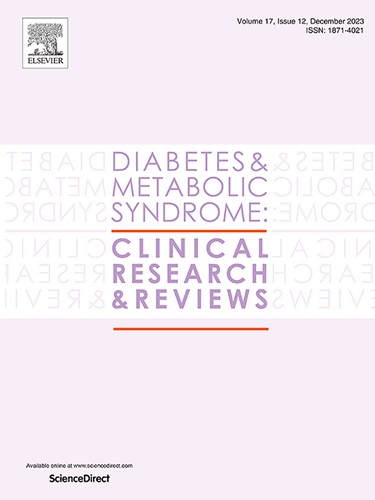Continuous glucose monitoring versus fasting blood glucose basal insulin titration: a retrospective analysis
IF 3.4
Q1 ENDOCRINOLOGY & METABOLISM
Diabetes & Metabolic Syndrome-Clinical Research & Reviews
Pub Date : 2025-06-01
DOI:10.1016/j.dsx.2025.103266
引用次数: 0
Abstract
Aims
Continuous glucose monitoring (CGM) may complement or potentially replace fasting blood glucose (FBG) for basal insulin dose titration in type 2 diabetes (T2D). This retrospective analysis compared CGM-based titration with FBG-based titration using 7354 pairs of FBG and blinded CGM data from a clinical study in 68 people with T2D.
Methods
Based on pharmacokinetic/pharmacodynamic simulations, the median of 3 lowest CGM values in the hour preceding the FBG timepoint (“1-h am nadir”) was selected as basis for titration. Basal insulin doses were determined using 3 algorithms (Canadian INSIGHT, Treat2Target, AT.LANTUS). Absolute/relative dose adjustment differences, mean absolute relative differences, and relative dose errors between CGM- and FBG-based doses were calculated.
Results
The 1-h am nadir was essentially equivalent to FBG for basal titration across all 3 algorithms. There was >90 % probability of the absolute dose adjustment difference being within tolerance. Mean absolute relative difference values were generally low, although higher for Treat2Target. Relative dose errors were mostly between −10 % and 10 %, indicating high agreement between CGM- and FBG-based titration and low clinical risk.
Conclusions
This study established that the 1-h am nadir can potentially be used as an FBG surrogate for basal insulin titration in T2D.
连续血糖监测与空腹血糖基础胰岛素滴定:回顾性分析
目的:连续血糖监测(CGM)可以补充或潜在地取代空腹血糖(FBG),用于2型糖尿病(T2D)的基础胰岛素剂量滴定。这项回顾性分析比较了基于CGM的滴定法和基于FBG的滴定法,使用了来自68例T2D患者的7354对FBG和盲法CGM的临床研究数据。方法基于药代动力学/药效学模拟,选取FBG时间点(“凌晨1小时最低点”)前1小时内3个最低CGM值的中位数作为滴定依据。基础胰岛素剂量采用3种算法(加拿大INSIGHT, Treat2Target, AT.LANTUS)确定。计算基于CGM和fbg剂量的绝对/相对剂量调整差、平均绝对相对差和相对剂量误差。结果在所有3种算法中,1小时的最低点基本等同于基础滴定的FBG。绝对剂量调整差在耐受范围内的概率为90%。平均绝对相对差值一般较低,但Treat2Target较高。相对剂量误差大多在- 10%到10%之间,表明基于CGM和fbg的滴定法一致性高,临床风险低。结论:本研究表明,空腹1小时的最低点可以作为t2dm患者基础胰岛素滴定的FBG替代指标。
本文章由计算机程序翻译,如有差异,请以英文原文为准。
求助全文
约1分钟内获得全文
求助全文
来源期刊

Diabetes & Metabolic Syndrome-Clinical Research & Reviews
ENDOCRINOLOGY & METABOLISM-
CiteScore
22.90
自引率
2.00%
发文量
248
审稿时长
51 days
期刊介绍:
Diabetes and Metabolic Syndrome: Clinical Research and Reviews is the official journal of DiabetesIndia. It aims to provide a global platform for healthcare professionals, diabetes educators, and other stakeholders to submit their research on diabetes care.
Types of Publications:
Diabetes and Metabolic Syndrome: Clinical Research and Reviews publishes peer-reviewed original articles, reviews, short communications, case reports, letters to the Editor, and expert comments. Reviews and mini-reviews are particularly welcomed for areas within endocrinology undergoing rapid changes.
 求助内容:
求助内容: 应助结果提醒方式:
应助结果提醒方式:


